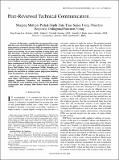Merging Multiple-Partial-Depth Data Time Series Using Objective Empirical Orthogonal Function Fitting
Author(s)
Lin, Ying-Tsong; Newhall, Arthur E.; Duda, Timothy F.; Lermusiaux, Pierre F. J.; Haley, Patrick
DownloadLin-2010-Merging Multiple-Par.pdf (1.907Mb)
PUBLISHER_POLICY
Publisher Policy
Article is made available in accordance with the publisher's policy and may be subject to US copyright law. Please refer to the publisher's site for terms of use.
Terms of use
Metadata
Show full item recordAbstract
In this paper, a method for merging partial overlapping time series of ocean profiles into a single time series of profiles using empirical orthogonal function (EOF) decomposition with the objective analysis is presented. The method is used to handle internal waves passing two or more mooring locations from multiple directions, a situation where patterns of variability cannot be accounted for with a simple time lag. Data from one mooring are decomposed into linear combination of EOFs. Objective analysis using data from another mooring and these patterns is then used to build the necessary profile for merging the data, which is a linear combination of the EOFs. This method is applied to temperature data collected at a two vertical moorings in the 2006 New Jersey Shelf Shallow Water Experiment (SW06). Resulting profiles specify conditions for 35 days from sea surface to seafloor at a primary site and allow for reliable acoustic propagation modeling, mode decomposition, and beamforming.
Date issued
2010-10Department
Massachusetts Institute of Technology. Department of Mechanical EngineeringJournal
IEEE Journal of Oceanic Engineering
Publisher
Institute of Electrical and Electronics Engineers
Citation
Lin, Ying-Tsong et al. “Merging Multiple-Partial-Depth Data Time Series Using Objective Empirical Orthogonal Function Fitting.” IEEE Journal of Oceanic Engineering 35.4 (2010): 710–721. Web. ©2010 IEEE.
Version: Final published version
Other identifiers
INSPEC Accession Number: 11673997
ISSN
0364-9059
1558-1691